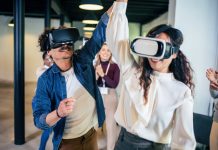Employees are busier than ever in the workplace, and most will say they simply don’t have time to learn. With more demands on employees’ time, little time is available to be allocated to professional development. Any time that can be allocated to development of new skills and competencies must be highly efficient and effective. In his book, “Brain Rules,” Dr. John Medina states, “The brain appears to be designed to solve problems related to survival in an unstable outdoor environment, and to do so in nearly constant motion.”
The keys to integrating learning into day-to-day routines are hidden in that statement: We must work with the brain not against it…solving problems…related to survival…in an unstable environment.This means training content mustmeet the learner where he or she is, instead of the other way around. What exactly does that mean? Content must be readily accessible within the learner’s natural work context, and the process of finding content that specifically meets the needs of learners must be frictionless and targeted. This is where a combination of a state-of-the-art learning discovery and delivery platform, combined with leading-edge microlearning content, is unbeatable.
Learning as a Habit, Not a Requirement
Today’s workers spend significant time using productivity and collaboration software applications and are always just a click away from accessing the Web. If a learning platform is not embedded in that application–Web ecosystem, it often creates a disconnect for employees. This disconnect causes a barrier between the question and the answer; if it is not integrated, employees will not take the time to log into a separate learning platform to access content in the moment of need. To address this disconnect, learning platforms should be immediately accessible—at the click of a button—within the worker’s immediate context or workflow. This is what the term, “contextualized learning,” stands for. Once a learner is in the learning platform, search and discovery of the most relevant learning content must a be a highly efficient and seamless process. Ideally, a learner can quickly search for content that addresses a specific issue or need and then find, in order of relevance, the content that is best designed to address that need.
The content itself should be created to make the learning experience enjoyable, efficient, and effective. To do so, content must be able to be consumed quickly by the learner (ideally in three to five minutes for most business skills learning content). Also, the instructional strategy used to design and develop the content should ensure maximum retention of the material for proactive application on the job. For example, for soft skills content, delivering negative feedback to a direct report exposes the learner to a quick interactive scenario that can effectively demonstrate desired behaviors the learner then can emulate in a scheduled feedback meeting.
An extension of the research on problem-based learning, which first was introduced by the medical faculty at McMaster University to improve medical students’ development of diagnostic competency, shows learning is most effective when it is connected to solving a tangible problem an employee faces. This is another way of viewing “contextualized learning.” The learning is connected to a pragmatic problem the learner is passionate about solving, and the learner is in the driver’s seat and responsible for finding a solution to the problem. We also know from research that learners are more likely to remember material they have learned when they are in the driver’s seat and when there is no question that what is being learned is useful and can be applied immediately. This represents a shift from the days when the primary delivery mode of development for employees was lengthy, classroom-based training and day-long sessions in remote locations. That kind of training increasingly is being challenged by the kind of “contextualized,” in-the-workflow training solutions that are made possible by a new generation of learning platforms that include effective microlearning and video-based e-learning content offered by training solutions providers such as Skillsoft.
The New, Modern Learning Experience
Providers must evolve their content development approach to ensure they are targeting the needs of modern learners for the best possible outcome. Instructional strategies and content design must be aligned to three specific requirements:
- More just-in-time and less just-in-case learning
- Visual, short, and relevant content to engage the modern learner
- Content that is designed for increasingly self-directed and specialized learning
A modern learning experience is achieved when a fully contextualized platform is combined with optimally designed content. This experience enables employees to integrate learning into their daily workflow and overcome the typical challenges imposed by limited time and busy schedules. More importantly, employers can make sure employees are continuing to grow their skills and competencies for strong execution in the workplace. A constantly improving workforce is key for an organization to maintain competitive advantage. In fact, the ability for human capital to continue to continue to develop, grow, learn, and contribute in new and different ways may be the only real sustainable competitive advantage for today’s organization.
SAMPLE CASE STUDY: Integrating Learning into the Day-to-Day Workflow
Sue leads a product development team of six. One of the members of the team, Jack, missed the delivery deadline for a high-profile prototype of a new product her team is working on. Sue needs to give Jack feedback, but because Jack is otherwise a strong performer, she wants to make sure she goes about it in the right away. She sets up a meeting with Jack in the next hour.
Sue has Google Chrome open because she was learning about a competitor’s recent product launch. Without closing out of the Webpage she was reading or opening a different platform, Sue easily clicks on the icon for her organization’s learning platform, which is embedded in Chrome. At the click of a button, Sue is able to search for content about “giving employee feedback” in the learning platform.
She finds a three-minute video on the topic titled, “Conducting an effective feedback session with an employee.” She reviews it and carefully watches how the leader in the video-based scenario delivers feedback in an effective manner. She observes the choice of words, how the leader starts the conversation on a positive note, body language, and other aspects of the content. She makes a note of the key points that appear on screen and then takes a screen capture of the course’s job aid so she can quickly review the critical pointers from the course just before the meeting.
In three minutes, Sue gained a lot more confidence in her ability to deliver the feedback she needs to provide to Jack so the team does not continue to miss project milestone delivery dates. She also learns how to use an approach that will keep him motivated and engaged.
That is how learning can be integrated into flow of work.
Heide Abelliis senior vice president of Content Product Management at Skillsoft,an industry leader driving innovative corporate learning solutions and technologies. Its mobile learning platform, Percipio,has been adopted by a diverse portfolio of clients. Most recently, Skillsoft released the Percipio Embedded Learning Synchronized Assistant (ELSA), which seamlessly integrates learning resources into an organization’s workflow.




